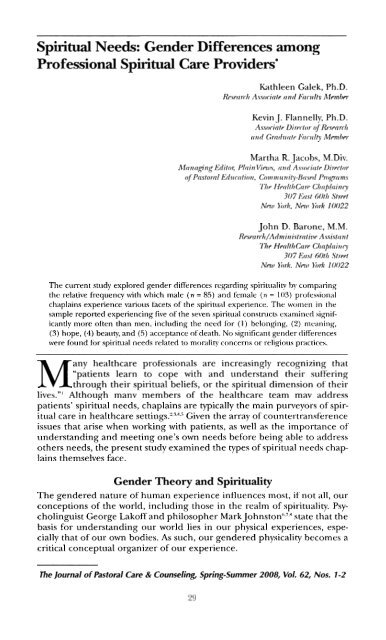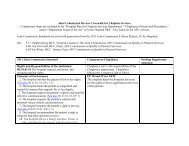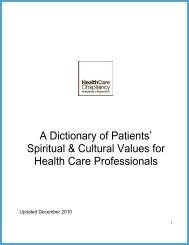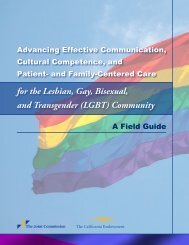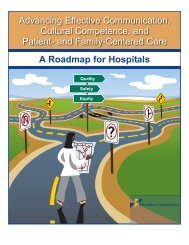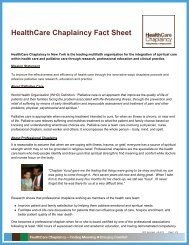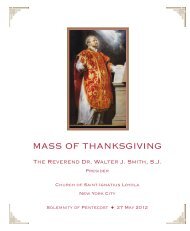Spiritual Needs Gender Differences - HealthCare Chaplaincy
Spiritual Needs Gender Differences - HealthCare Chaplaincy
Spiritual Needs Gender Differences - HealthCare Chaplaincy
Create successful ePaper yourself
Turn your PDF publications into a flip-book with our unique Google optimized e-Paper software.
<strong>Spiritual</strong> <strong>Needs</strong>: <strong>Gender</strong> <strong>Differences</strong> among~iofessional <strong>Spiritual</strong> Care Providers*Kathleen Galek, Ph.D.h'rsr:crrn-11 :l.xsori~r/r crnd I+rrrr//y ~ \f~ml~~rKevin-J. Flannelly, Ph.D.,$ssorirrl~ Diwlor- of IILvr~rrrrlr(1t1r1 G~U(/II(I/P F~ICII //y h~Imr/~~r-Martha R. Jacobs, M.Div.hf(rn(rp.ng Edilo~ f'l/lirr \';nil.\, /III(/ A s\ori(~/r Dirrrlorof Prrslornl E~lrtrcr/io~r. Co III rrt rt n i/~-Hrl \P// I'royr/lms?YIP I!~,cr/ll~C(r~-r C/I/I/I/~I~II~J307 k..(rc/ 60111 S/p~r/Nncr Ii~rk, Nno lhrk 10022John D. Barone, M.M.R~.s~~rrrl~/;idnri~~i.~~rr~/i~~~A rsi.s/nrr/771~ HP(II//IC/IIT C/I(I/~/(I~?I~307 E(I.\/ 60111 .S/rw/h'm~ lid. Nncr }irk 10022The current study explored gender dityerences regarding spiritu;~litv by comparingthe relative frequency with which male (n = 85) and female (71 = 103) professionalchaplains experience xmious facets of the spiritual experience. The wornen in thesample reported experiencing five of' the seven spiritual constnlct.; exarllincd signif'icantly more ofien than men, including the need fbr (1) belonging, (2) mcaning,(3) hope, (4) beaut): and (5) acceptance of death. No significant gender tliff'erenceswere found for spiritual needs related to rno~ility concerns or religious practices.Many healthcare professionals are increasingly recognizing that"patients learn to cope with and understand their sufferingthrough their spiritual beliefs, or the spiritual dimension of' theirlives."' Althoucrh manv- members of the healthcare team mav addressL,patients' spiritual needs, chaplains are typically the main punreyors of spiritualcare in healthcare settings.'.'.".' Given the array ofco~intertranskrenceissues that arise when working with patients, as well as the importance of'understanding and meeting one's own needs before being able to addressothers needs, the present study examined the types of spiritual needs chaplainsthemselves face.<strong>Gender</strong> Theory and <strong>Spiritual</strong>ityThe gendered nature of human experience influences most, if not all, ourconceptions of the world, including those in the realm of spirituality. PsycholinguistGeorge Lakoff and philosopher MarkJohnston",'" state that thebasis for understanding our world lies in our physical experiences, especiallythat of our own bodies. As such, our gendered physicality becomes acritical conceptual organizer of our experience.The Journal of Pastoral Care & Counseling, Spring-Summer 2008, Vol. 62, Nos. 1-2
The field of the~biolo~gy. which explores the interface between theolo
Constructs and Their Corresponding ItemsConstructsLove/Belonging/RespectDivinePositivity/Gratitude/Hope/PeaceMeaning and PurposeMorality and EthicsAppreciation of BeautyItemsTo he ;~ccepted as a personFov cornpanionshipTo give/receive loveFor comp;ission and kindnessFor respectfill care of your boclily neeclsTo feel a sense of connection wit11 the \\,orldTo participate in religious or- spi~-irr~:il servicesTo have someone pray wit11 or fi)~- yo11To perhrnm religious or spiritual ~.itr~alsTo read spiritual or religious m;ito.i;tlFor guidance from a higher powerTo tee1 hopefillTo Feel a sense of peace iund contentllirntTo keep a positive outlookTo have a quiet spacr to rneclitate or I-ellectTo he thanktl~l 01- gratetl~lTo experience a sensc oF laughter ancl hurnorTo find meaning in the sutti-ringTo find meaning ~mtl purpose in litkTo make sense of' why this meclical pl.ohlernhi~ppened to yotiTo live an ethicirl ancl moral liteTo experience or appreciate beautyTo experience or appreciate muhicTv experience or appreckite natureTo adclress unrnet issues heti,re deathTo aclclress concerns ahout lilt after deathTo have a deeper rlnderstanding of cleathancl clyingTo forgive yot~rself and othersTo review your lice
ResultsFactor analysis was conducted on the 28 items to attempt to confirm theseven spiritual needs constructs developed by Galek, P/ (11."' Cronbach'salpha (a) was calculated on the items comprising each construct to providea measure of internal consistency of each construct. The seven categories,or constructs, of spiritual needs were: Love/Belonging/Respect (a= .76), Divine (a = .70), Positivity/Gratitude/Hope/Peace (a = .70), Meaningand Purpose (a = .73), Appreciation of Beauty (a = .74), and Resolution/Death(a = .57). An alpha value was not calculated for the Ethicsconstruct since it consisted of only one item.MANCOVA revealed a significant effect for gender across constructs,after controlling for years as a chaplain [1;(7, 179) = 2.22, p < ,051. Subsequentunivariate analyzes found significant gender effects for five of theseven constructs. Female chaplains gave higher relative fi-equency ratingsthan did male chaplains to the following constructs: I,ove/Belonging/Respect, Divine, Positivity/Gratitude/Hope/Peace Meaning and Purpose,Appreciation of Beauty, and Resolution/Death. <strong>Gender</strong>s did not significantlydiffer with regard to the following two constructs: Ethics/Moralit.yand the Divine.DiscussionThe current study revealed systematic differences in the spiritual needs ofmale and female chaplains. Women were more in touch with their spiritualneeds in the areas of love/belonging, positivity/hope, meaning, appreciationof beauty, and resolution/death than were the men in our study. Nogender differences were observed with respect to ethics or institutional andprivate religious practices con~prising the Dir' rlne construct.The understanding of any gender difference rests within a complexinteraction of many realms. An examination of the interplay of gender andspirituality through the lens of history reveals that early theologians associatedwomen with the feminine body, nature and darkness, whereas theyassociated men with the mind and spirit."' However, since gender and spiritualityco-exist in a continually changing biopsychosocial context, how canwe understand this current snapshot of gender diff'erences in the spiritualneeds of professional chaplains?Theorists such as Chodorow" and Gilligan" have put fbrth a developmentalparadigm in which female identity is based on a web of connectionsto others. Gilligan,"' in particular, has suggested that women essentially usea "dif'ferent voice" from that of males-that women speak a language basedon the care and nurturance of others, while men speak a language that isframed in terms of autonomous separation. Findings from the currentstudy may reflect this overall trend for women to be more attuned to theirown spiritual relatedness, as well as attuned to the spiritual relatedness ofothers. However, research examining the personal characteristics of maleclergy has found that male ~1er~g-y and seminarians score higher than mostmen in the general population on such traditionally feminine traits as sensitivityand passivity. Studies have also found that male clergy exhibit agreater interest in the aesthetics of art, literature, and music, as well as apreference for working through problems in a non-competitive manner."I2'Thus, clergymen appear to have a more highly developed nurturing andaesthetic sense than other men.
The finding that male and female chaplains did not differ with respectto the importance they placed on institutional and private religious practicesis consistent with the findings of Flannelly and Galek,"' which revealedno gender differences among chaplains or other healthcare professionalsregarding their self-reported levels of religiosity. <strong>Differences</strong> between theconcepts of religion and spirituality have been widely discussed in thehealthcare literature, especially in nursing.".'":-"',"'."." Religion is consideredby many authors to be a manifestation of spirituality within the context ofinstitutional religious beliefs and practices.'"," The concept of' spirituality isusually thought of as being broader than that of religion,""^"'." and not necessarilyexpressed through religious belief5 or practices, although some docertainly express their spirituality through religion.The findings of Flannelly and Galek'blso showed that overall, femalehealthcare professionals tended to be more spiritual than males, especiallyamong nurses and social workers. However, male chaplains reported thesame levels of spirituality as did female chaplains. While both male andfemale chaplains report higher levels of spirituality than healthcare professionalsin other disciplines, the present study perhaps offers a more nuancedunderstanding of the gendered contours of spirituality among chaplains.The current study revealed that female chaplains place more importanceon exploring issues relating to death and dying than the men in oursample. In his discussion of the Heroic Myth, Ernest Becker explores howheroics facilitate the denial of death, allowing one to feel permanent, invulnerableand eternal."' Taking on the heroic archetype, according to Becker,also enables one to embrace the existential paradox of "individualitywithin finitude.""" Men may identi* more with the Heroic Myth of conqueringdeath, as opposed to Lief's concept of "making friends withdeath," which suggests that "cultivating an awareness of death is at the sametime cultivating an awareness of life."."Finally, our study found no difference between male and female chaplainswith respect to their need to incorporate morality and ethics intotheir lives. Since theorists and researchers have written extensively aboutgender differences regarding the ethics of care,justice, and morality,'" furtherresearch would be usefirl to understand the connections among gender,spirituality and ethics.The recruitment of participants may be seen as a major limitation of thestudy, since potential participants were not directly contacted about thestudy. Instead, they were solicited indirectly through an announcementposted in a newsletter. Since we do not know the number of people whoeven saw the announcement we cannot calculate the actual response rate.Regardless of the number of chaplains who saw or read the announce-ment, the number of responses was quite small in comparison to the thousandsof individuals who receive the newsletter r~ic~ the internet.ConclusionThe nature of the caregiver relationship in chaplaincy, as in other healthprofessions, requires spiritual-care providers to call upon both their masculineand feminine attributes." Trothen" reminds us that "gender stereotypesserve to confine and limit us; people with a variety of gifts are neededin ministry" (p. 33). Trothen note~.~~however, that there is a "pervasive,often unconscious expectation" (p. 33) in our culture that faith leaders
work within the dominant paradigm of niasc~~linity, which "values the rationalover the unproven, the head over the heart, [and] the mind over thespirit" (p. 33)."'Within the context of this cultural bias, the question arisesof how to promote an ethic of care within clinical ministry in whichproviders can draw equally from both their Feminine and masculine characteristicsand resources." %Endnotes*The al~thors tl~ank the John Templeton Foundation, the Authur \'inins Davis Fou~rtlatioris.and The Starr Foundation for tl1ei1- geriero\~support. Thc ar1t11o1.s ;ilso thank tl~c. Rcsc;i~-chLibrarian Helen Tannenbar~m.1. Christina Puchalski and Anna L. Ron1t.l; "Taking a Spiritu;tl Histoy Alli)ws Clinicians toUndel-st;und P;itients hlorc Fully.",]r~rr~~rnl r!/ I'(tllro/irr, Afrrlrl-III~: 2000, \Iol. 3, No. I , pp. 1 ?!)-I 37.2..John E. Bahlcr, "A Colnparison 01' <strong>Spiritual</strong> C~I-e Proipitietl by Sc1ci;ll Mrol.kerh. N11rsc3, andSpirit~~al Cal-e Prottssionals," 771r Hos/~rw,/~~rrrr~~rI, 1!407. 1'01. 12, No.4, pp. 15-28.:I.,lulia D. Emblen and Lois Halst~atl, "<strong>Spiritual</strong> Neetls ant1 lnte~~er~tionh: (;~III~;II.~II~ the \'iews01' Patients, Nurses, and Chaplains," Cli~ril-rrl iVlrnr S/~,(irrli\l, 1093, \+)I. 7, No:l, pp. 175-IHL'.4. James L. Gibbons, John Thomas, L~I-I? \'andeCrrek, & Arne I
24. R. Scott Sl~llendel; "Clergy Candidates Mh,lPI profiles: (:omp;tring Gentler ;III(~ Age \';iriables,"7%1~,/11rtnrnl (I/ I'/is/rrrrrl (,'om, 1999. \!ol. 47, 80.3, pp. 263-273.25. Philip ,I. Keddy, Philip Elrlberg, 8c Seitri D. Sammons, "The Psychologic;~l Assessn~e~~t ofCatllolic Clerm and Religious Reterred tbr Residenti;~l Treatntc:nt." I'rr.\/ot~rrl I'y~-ltob~,:~, I$)tlO,\'ol. 38. No.3, pp. 147-1.59.26. Kevin ,I. E'lannelly and Lthleen Calek, "A Discipline ant1 Sex Diffial-cnces in, Religiosity,Spi~.itr~;tlity arnong Health Care Prolkssioiials," I'?\'drol~~,~~I~~/i/ lir/~or-I.\, 2OOli, \foI. !):I. No. 3, pp.80940%.25. Priscilla Berggren-Thontas ant1 Mnrcell;~,l. Griggs, "Spir.itu;tlity in Agi~tg: Spiritu;tl Neetl 01-Spiritl~al Jo~~r~~ey?"~/orirri~iIIT/ (>~~II~~I/~~/o~~I~~I/"v7ritxiti~r, 1


